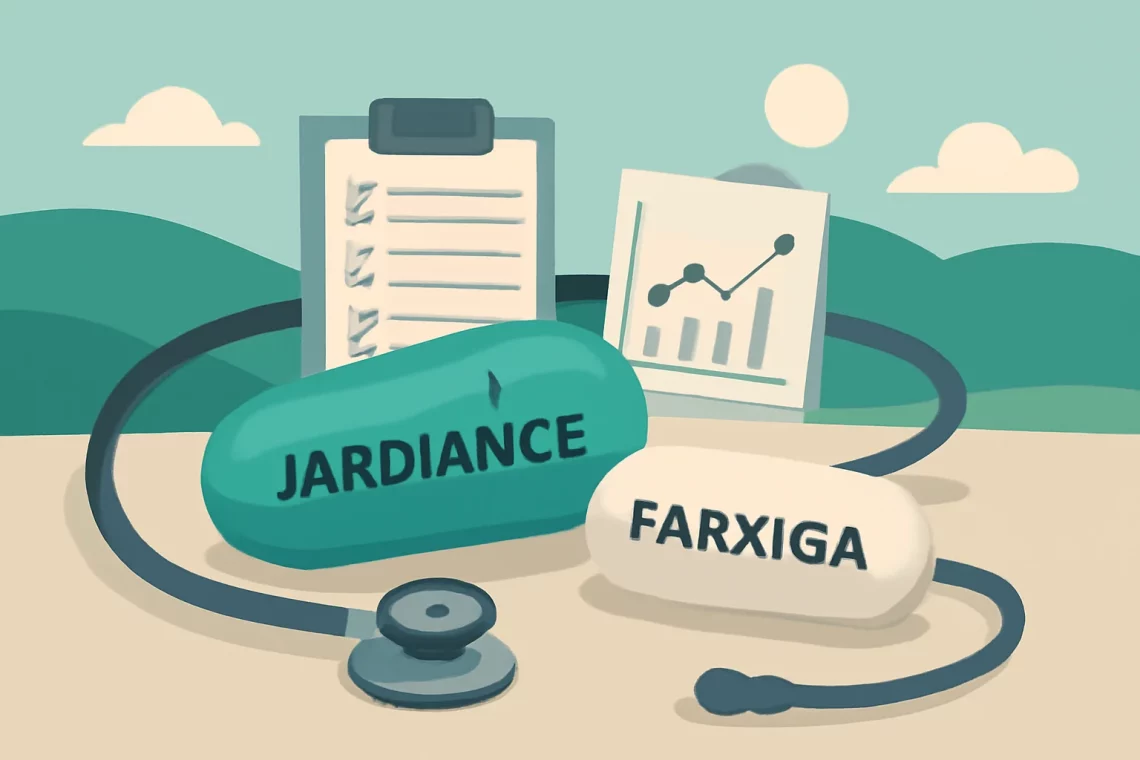
Jardiance vs Farxiga: Which Diabetes Medication is Right for You?
In the ever-evolving landscape of diabetes management, two medications have emerged as prominent players: Jardiance and Farxiga. Both of these drugs belong to a class known as SGLT2 inhibitors, which work by helping the kidneys eliminate excess glucose through urine. As diabetes rates continue to soar globally, the importance of effective treatment options cannot be overstated. Patients and healthcare providers alike are constantly seeking the most effective and convenient medications to manage blood sugar levels while minimizing side effects.
Jardiance and Farxiga not only help in controlling diabetes but also offer additional benefits, such as weight loss and cardiovascular protection. However, the choice between these two medications can be daunting for many. Factors like efficacy, side effects, and individual health profiles play a crucial role in determining the best option for each patient. Understanding the nuances of each medication, including how they function and their potential impact on overall health, is essential for informed decision-making. This article aims to shed light on the differences and similarities between Jardiance and Farxiga, providing a comprehensive overview to assist patients, caregivers, and healthcare professionals in navigating this important decision.
Mechanism of Action
Jardiance and Farxiga operate through a similar mechanism of action, as they are both classified as SGLT2 inhibitors. By inhibiting the sodium-glucose co-transporter 2 (SGLT2) in the kidneys, these medications prevent glucose reabsorption, which leads to increased glucose excretion in urine. This mechanism is particularly beneficial for individuals with type 2 diabetes, as it helps lower blood sugar levels effectively.
When glucose is not reabsorbed, it is expelled from the body through urine, which not only aids in controlling blood sugar but also has a diuretic effect, leading to potential weight loss. Jardiance and Farxiga can also impact the body’s insulin sensitivity and promote a reduction in insulin resistance over time. This dual action can assist patients in achieving better glycemic control while also addressing other metabolic issues commonly associated with type 2 diabetes.
The differences between Jardiance and Farxiga, however, lie in their specific formulations and the extent of their benefits. Jardiance, for instance, has been associated with a significant reduction in cardiovascular risk. Clinical trials have shown that it can lead to lower rates of hospitalization for heart failure and other cardiovascular complications. Farxiga, on the other hand, has demonstrated protective effects on kidney function, making it a valuable option for patients who may be at risk for diabetic kidney disease.
Understanding the precise mechanism by which these medications work allows patients and healthcare providers to make informed choices based on individual health needs and treatment goals.
Clinical Benefits and Efficacy
Both Jardiance and Farxiga have been proven effective in managing blood glucose levels in individuals with type 2 diabetes. However, clinical benefits extend beyond glucose control alone. Research has shown that these medications can reduce the risk of major cardiovascular events, a critical consideration for many patients, especially those with a history of heart disease.
Jardiance has been highlighted for its cardiovascular benefits, with studies indicating a significant reduction in the risk of cardiovascular death among patients using the medication compared to those on a placebo. This effect is particularly important for patients with diabetes, who are at a higher risk for heart-related complications. Additionally, the weight loss associated with Jardiance can further enhance cardiovascular health, as maintaining a healthy weight is a key factor in reducing heart disease risk.
On the other hand, Farxiga has been recognized for its renal protective effects. Studies have shown that it can slow the progression of kidney disease in diabetic patients, making it a strong contender for those who may be experiencing early signs of diabetic nephropathy. This ability to protect kidney function can have a significant impact on long-term health outcomes and overall quality of life.
Patients may also experience improvements in other areas, such as blood pressure reduction, with both medications offering additional health benefits. Choosing between Jardiance and Farxiga might ultimately come down to personal health priorities. For someone with a history of heart disease, Jardiance may be the preferable choice, while a patient with kidney concerns might lean towards Farxiga.
Understanding the clinical benefits and efficacy of these medications can empower patients to have informed discussions with their healthcare providers, ensuring that their treatment plan aligns with their overall health goals.
Side Effects and Considerations
While Jardiance and Farxiga offer numerous benefits, it is essential to consider potential side effects associated with their use. Both medications may cause similar adverse effects, including urinary tract infections (UTIs) and genital infections due to increased glucose in the urine, creating an environment conducive to bacterial growth.
In rare cases, patients may experience more severe side effects, such as ketoacidosis, a serious condition that can occur when the body produces high levels of ketones. Symptoms may include nausea, vomiting, abdominal pain, and difficulty breathing. Patients should be educated on recognizing these symptoms and seeking immediate medical attention if they occur.
Furthermore, dehydration can be a concern due to the diuretic effect of SGLT2 inhibitors, which may lead to hypotension or dizziness, particularly in older adults or those taking medications that affect blood pressure. It is crucial for patients to maintain proper hydration and discuss any concerns about dizziness or lightheadedness with their healthcare provider.
Before starting either medication, patients should disclose their complete medical history, including any existing kidney issues or other health conditions. Jardiance and Farxiga are not recommended for individuals with severe renal impairment, and a healthcare provider can help evaluate the patient’s kidney function to determine the most appropriate treatment option.
Ultimately, while both medications offer substantial benefits for managing diabetes, understanding potential side effects and considerations is vital for ensuring safe and effective treatment. Patients should feel empowered to discuss any concerns with their healthcare provider to tailor their diabetes management plan to their unique health profile.
Cost and Accessibility
The cost of diabetes medications can be a significant barrier for many patients, making it essential to consider not only the efficacy and side effects of Jardiance and Farxiga but also their affordability and accessibility. Pricing can vary widely based on factors such as insurance coverage, pharmacy location, and whether patients qualify for any patient assistance programs.
In general, both Jardiance and Farxiga are available as brand-name medications, which can be costly without insurance. However, many pharmaceutical companies offer savings programs, copay cards, or patient assistance programs to help reduce out-of-pocket costs for eligible patients. It is advisable for patients to check with their healthcare provider or pharmacist to explore any available financial assistance options.
Additionally, some insurance plans may have different tiers for medication coverage, which can impact the overall cost. Patients should review their insurance formulary to understand how their plan covers these medications and whether prior authorization is required.
Generic alternatives, while not available for these specific medications, can also be a consideration for patients looking for more affordable options. Consulting with a healthcare provider about potential alternatives or combination therapies may lead to more cost-effective treatment plans without compromising efficacy.
Ultimately, cost and accessibility are crucial factors in medication adherence and overall diabetes management. Patients should feel empowered to engage in open conversations with their healthcare providers about financial concerns to ensure they can access the medications they need for effective diabetes care.
In conclusion, while Jardiance and Farxiga are both effective SGLT2 inhibitors for managing type 2 diabetes, the choice between the two should be based on individual health needs, potential benefits, and side effects. It is vital to work closely with healthcare professionals to make an informed decision that aligns with personal health goals.
**Disclaimer:** This article is not intended as medical advice. Always consult with a healthcare professional for any health-related concerns or questions regarding medication.




